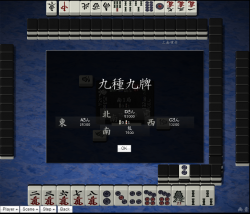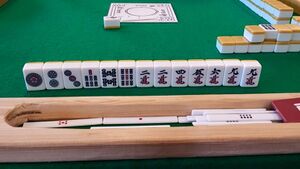Daburu riichi: Difference between revisions
m (Added links) Tags: Visual edit Mobile edit Mobile web edit |
(remove fluff; reword the conditions for the yaku to: "if the player reaches tenpai before their first discard AND before any tile calls") |
||
| Line 10: | Line 10: | ||
* [http://tenhou.net/0/?log=2016072423gm-00a9-0000-b0aed9e0&ts=8&tw=2 Double riichi denied] | * [http://tenhou.net/0/?log=2016072423gm-00a9-0000-b0aed9e0&ts=8&tw=2 Double riichi denied] | ||
}} | }} | ||
'''Daburu riichi''' {{kana|両立直}} or {{kana|ダブルリーチ}}, is simply '''double riichi'''. | '''Daburu riichi''' {{kana|両立直}} or {{kana|ダブルリーチ}}, is simply '''double riichi'''. It is a special case for [[riichi]] on the first turn. Specifically, if the player reaches [[tenpai]] before their first discard (i.e., within the first 14 tiles), and before anyone has made a [[Naki|tile call]], then riichi turns into double riichi. Double riichi is worth 2 han instead of the usual 1 han. | ||
Double riichi is | Double riichi is not mandatory, but rarely do players decline an opportunity for it. In addition to the added han, a double riichi hand is much faster than the average hand. | ||
== Cancellation == | |||
Double riichi is not possible when anyone makes a tile call before you, even if you have tenpai on the first turn. A player's own [[kan]] will deny this yaku. In [[sanma]], [[kita]] calls will also deny this yaku. | |||
== Tenhou and Chihou == | == Tenhou and Chihou == | ||
| Line 21: | Line 24: | ||
== Defending against double riichi == | == Defending against double riichi == | ||
[[Image:Double riichi denied.png|thumb|right|250px|[http://tenhou.net/0/?log=2016032809gm-0089-0000-19c59dbd&tw=1&ts=7 Double riichi] stopped by [[kyuushu kyuuhai]].]] | [[Image:Double riichi denied.png|thumb|right|250px|[http://tenhou.net/0/?log=2016032809gm-0089-0000-19c59dbd&tw=1&ts=7 Double riichi] stopped by [[kyuushu kyuuhai]].]] | ||
Double riichi's greatest advantage, aside from its speed, is the lack of information regarding [[safe tiles]] at the beginning of the hand. Initially, every tile is considered to be dangerous, as no to few discarded tiles show any indication of safe tiles. However, this advantage can be worn away | Double riichi's greatest advantage, aside from its speed, is the lack of information regarding [[safe tiles]] at the beginning of the hand. Initially, every tile is considered to be dangerous, as no to few discarded tiles show any indication of safe tiles. | ||
However, this advantage can be worn away through the [[furiten]] rule. While a player in riichi, every tile not claimed for a win is considered safe against the riichi caller. If a winning tile does not come soon enough, the other players may themselves reach tenpai. If affordable, a player may employ [[sashikomi]], in the hope of dealing into a cheaper hand. | |||
For more unusual situations, the threat of a double riichi can be averted by ending the hand via [[Tochuu ryuukyoku|abortive draw]]. [[Kyuushu kyuuhai]] can immediately end the hand before the declarer can claim tsumo. An even more unusual possibility can end with suufon renta. Eventual means can be provided by [[sanchahou]], [[suu kaikan]], or even a risky [[suucha riichi]]. | For more unusual situations, the threat of a double riichi can be averted by ending the hand via [[Tochuu ryuukyoku|abortive draw]]. [[Kyuushu kyuuhai]] can immediately end the hand before the declarer can claim tsumo. An even more unusual possibility can end with suufon renta. Eventual means can be provided by [[sanchahou]], [[suu kaikan]], or even a risky [[suucha riichi]]. | ||
Revision as of 06:13, 17 March 2024
| Type | Yaku |
|---|---|
| Kanji | 両立直 or ダブルリーチ |
| English | Double ready |
| Value | 2 han |
| Speed | Immediate |
| Difficulty | At discretion |
Daburu riichi 「両立直」 or 「ダブルリーチ」, is simply double riichi. It is a special case for riichi on the first turn. Specifically, if the player reaches tenpai before their first discard (i.e., within the first 14 tiles), and before anyone has made a tile call, then riichi turns into double riichi. Double riichi is worth 2 han instead of the usual 1 han.
Double riichi is not mandatory, but rarely do players decline an opportunity for it. In addition to the added han, a double riichi hand is much faster than the average hand.
Cancellation
Double riichi is not possible when anyone makes a tile call before you, even if you have tenpai on the first turn. A player's own kan will deny this yaku. In sanma, kita calls will also deny this yaku.
Tenhou and Chihou
It is very much possible to call a double riichi and be in furiten from the beginning. This can only be done with a hand qualifying for either tenhou or chiihou. However, this is a dubious play, either intentionally or unintentionally passing up yakuman. For this reason, it is unwise to be hasty about the prospect of a double riichi.
Defending against double riichi

Double riichi's greatest advantage, aside from its speed, is the lack of information regarding safe tiles at the beginning of the hand. Initially, every tile is considered to be dangerous, as no to few discarded tiles show any indication of safe tiles.
However, this advantage can be worn away through the furiten rule. While a player in riichi, every tile not claimed for a win is considered safe against the riichi caller. If a winning tile does not come soon enough, the other players may themselves reach tenpai. If affordable, a player may employ sashikomi, in the hope of dealing into a cheaper hand.
For more unusual situations, the threat of a double riichi can be averted by ending the hand via abortive draw. Kyuushu kyuuhai can immediately end the hand before the declarer can claim tsumo. An even more unusual possibility can end with suufon renta. Eventual means can be provided by sanchahou, suu kaikan, or even a risky suucha riichi.
External links

- Daburu riichi in Japanese Wikipedia
| |||||||||||||||||||||||||||||||
